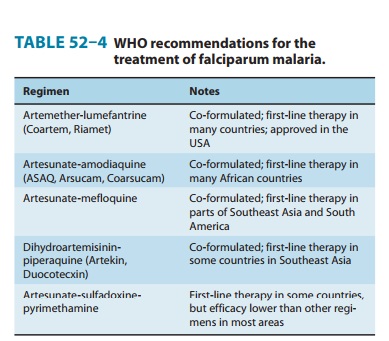Chapter: Basic & Clinical Pharmacology : Antiprotozoal Drugs
Other Quinolines - Malaria
OTHER QUINOLINES
Amodiaquine
is closely related to chloroquine, and it probably shares mechanisms of action
and resistance with that drug. Amodiaquine has been widely used to treat
malaria because of its low cost, limited toxicity, and, in some areas, effectiveness
against chloroquine-resistant strains of P
falciparum. Reports of toxicities of amodiaquine, including
agranulocytosis, aplastic anemia, and hepatotoxicity, have limited use of the
drug in recent years. However, recent reevaluation has shown that serious
toxicity from amodiaquine is rare, and it may be used as a replacement for
chlo-roquine in areas with high rates of resistance but limited resources. The
most important current use of amodiaquine is in combination therapy. The World
Health Organization (WHO) lists amodiaquine plus artesunate as a recommended
therapy for falciparum malaria in areas with resistance to older drugs (Table
52–4). This combina-tion is now available as a single tablet (ASAQ, Arsucam,
Coarsucam) and is the first-line therapy for the treatment of uncomplicated
falciparum malaria in many countries in Africa. Another combina-tion,
amodiaquine plus sulfadoxine-pyrimethamine, remains reasonably effective for
the treatment of falciparum malaria in many areas with some resistance to the
individual drugs, and it ispreferred alternative treatment if artemisinin-containing
thera-pies are unavailable. Chemoprophylaxis with amodiaquine is best avoided
because of its apparent increased toxicity with long-term use.

Piperaquine is a bisquinoline that was used widely to treat chloroquine-resistant falciparum malaria in China in the 1970s through the 1980s, but its use waned after resistance became widespread.
Recently, piperaquine has been combined with dihydroartemisinin
in co-formulated tablets (Artekin, Duocotecxin) that have shown excellent
efficacy and safety for the treatment of falciparum malaria, without apparent
drug resistance. Piperaquine has a longer half-life (∼ 28 days) than amodiaquine (∼ 14 days), mefloquine (∼ 14 days), or lumefan-trine (∼ 4 days), leading to a longer
period of post-treatment prophylaxis with dihydroartemisinin-piperaquine than
with the other leading artemisinin-based combinations; this feature should be
particularly advantageous in high transmission areas.
Dihydroartemisinin-piperaquine is now the first-line therapy for the treatment
of uncomplicated malaria in Vietnam.
Related Topics